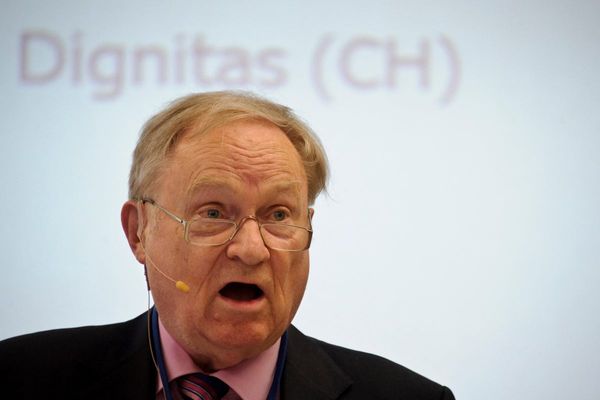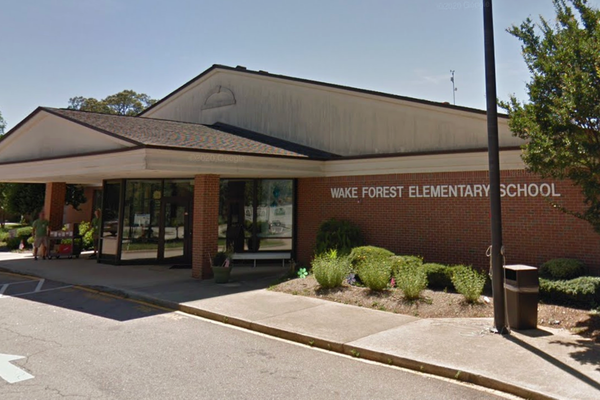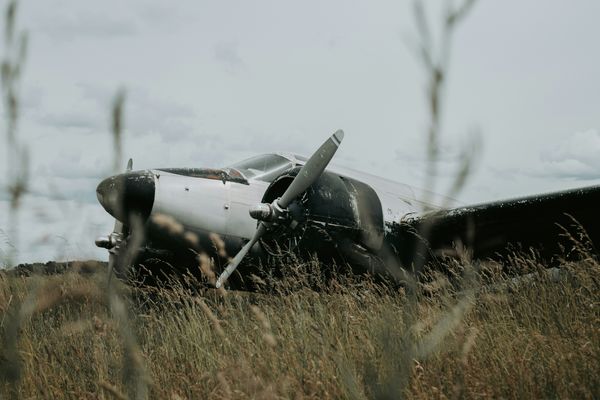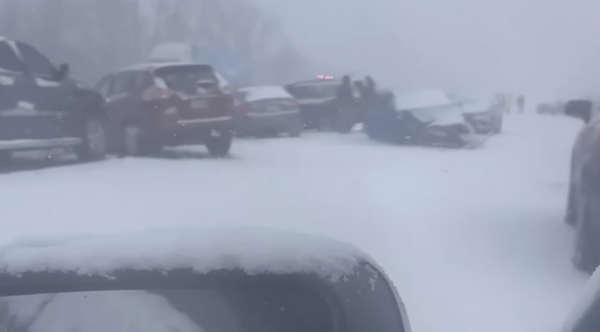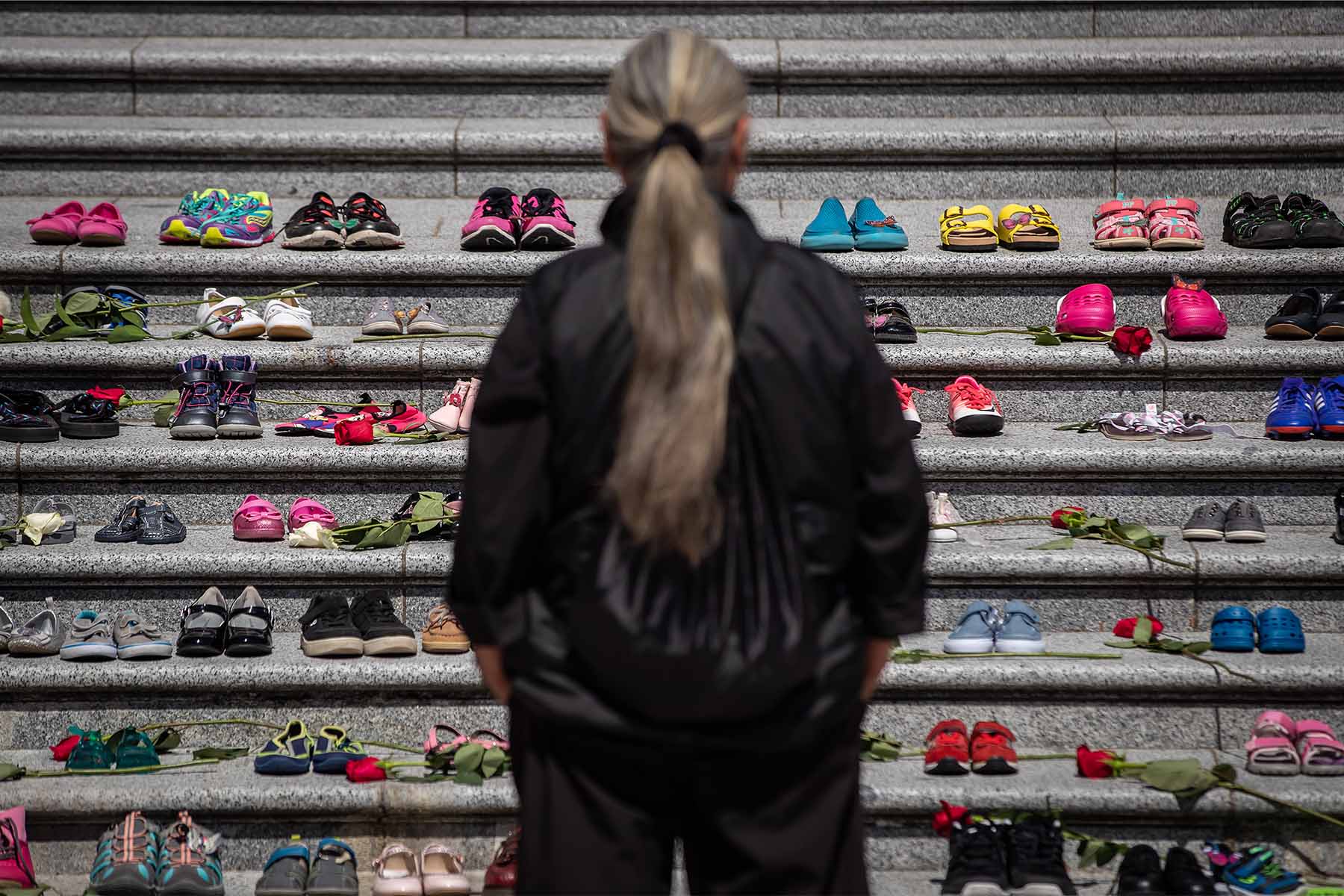
In 2021, Haida artist Tamara Rain Bull placed 215 pairs of children’s shoes and stuffed animals on the steps of the Vancouver Art Gallery. The display was intended to stand for the unmarked graves found that year at the site of the former Kamloops Indian Residential School. Bull’s unsanctioned memorial has remained on those steps for two years. For many, it has been a space to gather and grieve for the thousands of Indigenous children who never returned home from residential schools, a staggering visual representation of loss and heartbreak.
But for others, the memorial means something else entirely. “[T]his is pretty straightforward, what they’re doing,” said former Vancouver city councillor Gordon Price in a 2022 interview with CBC reporter Angela Sterritt. “It’s theirs; that’s what I think they think about it. And [it’s] permanent: this is how we do shame and guilt. We will never not have a reminder.”
Since the Truth and Reconciliation Commission (TRC) published its final report in 2015, which was informed by the testimonies of thousands of survivors, Canadians have been grappling with an awareness of the residential school system and its legacy. This awareness has facilitated a genuinely remarkable cultural shift. In the classroom, many students are now learning about the federally funded residential schools that operated in Canada until 1997—that is, until just a decade or so before they were born. And many adults are now familiar with the basic facts: more than 150,000 Indigenous children were sent to these institutions, where physical and sexual abuse was rampant and common and where thousands died due to neglect, overcrowding, and abuse. In 2021, the Government of Canada declared September 30 as a statutory holiday, and however cynical one might be about paid holidays for federal employees as a meaningful form of change, it indicates an undeniable degree of national recognition.
And yet Price’s remarks about the memorial are representative of a swelling tide of resentment among many Canadians, the dark inverse of the nascent national reckoning. Price didn’t dispute the grim history represented by the memorial; he only resented being confronted with it. But many others have taken their discomfort a step further by insisting that there must be another version of events, an alternate history of residential schools.
As defined by scholars Daniel Heath Justice and Sean Carleton, residential school denialism is “the rejection or misrepresentation of basic facts about residential schooling to undermine truth and reconciliation efforts . . . in ways that ultimately protect the status quo as well as guilty parties.” This was on display in 2017, when former senator Lynn Beyak delivered a speech in the Senate arguing that residential schools were well intentioned and had positively impacted the lives of many Indigenous people, later saying in an interview with the CBC, “There were two sides to every story.” Beyak was widely condemned for her remarks and resigned from the Senate in 2021 without apology. But her speech was grounded in the doctrine of denialism, which is that there must be a good story for every bad one and a hero for every villain—a kind white settler, just like them, who would never have participated in a truly evil system.
The Cree author Tomson Highway is often cited for this purpose. Highway has spoken positively about his years at the Guy Hill Indian Residential School and credits the education he received for much of his success. Those who cherry-pick certain statements by Highway probably haven’t read his memoir, Permanent Astonishment, which recalls how, from the age of eleven, he was molested regularly by a school staff member who Highway estimates also molested a hundred other boys. “The results are horrific,” he writes of the abuse. “Their lives are destroyed. And they think about it and think about it and think about it. Sometimes to make the thinking stop, they kill themselves. And the fallout goes on to affect the next generation and the next and the next.”
Of course, Highway isn’t entirely alone. Within the hundreds of survivor testimonies gathered by the TRC, there are positive recollections about sports, friendships, teachers who were kind and encouraging. My own grandmother, who attended St. Michael’s Indian Residential School in Duck Lake, Saskatchewan, also spoke warmly of her time there. That doesn’t erase the abuse experienced at St. Michael’s by countless others, including the father of Cree journalist Connie Walker, who investigated the institution’s history in the 2022 podcast Stolen. No survivor’s story is uncomplicated. Fred Sasakamoose, the first status Indian to join the NHL, also attended St. Michael’s, and he credited the hockey-loving priests, who beat him regularly, for his training. But his success didn’t erase his suffering. In 2012, he told the TRC that he never wanted to be a hockey player: “All I wanted was my parents.”
It might be tempting to simply write off people with views like Price’s or Beyak’s as contrarian conspiracy theorists—the Flat Earthers of reconciliation. But like a carbon monoxide leak, their words have the effect of addling the minds of otherwise rational people who might not agree with everything but find themselves wondering aloud: Maybe residential schools weren’t all bad?
Since Beyak’s resignation, and since Kamloops, denialism has mutated into a more virulent, reality-resistant strain. Tom Flanagan—adviser to Stephen Harper when he was prime minister; long-time opponent of Indigenous rights—told the New York Post in 2022 that the graves were “fake news” because he had yet to see any bodies. Flanagan, as well as many others, also seized upon the term “mass graves,” used in early reporting on Kamloops, as implausible and inaccurate—as if hundreds of unmarked individual graves are somehow less horrific. Doubters also took the decision of Tk’emlúps te Secwépemc First Nation not to immediately excavate the graves in Kamloops as “proof” that none exist. And though other First Nations have begun positively identifying the children in unmarked graves by linking church and school records, clamouring calls for “evidence” in the form of unfettered access to the remains of Indigenous children is now a predictable response to any story about residential schools.
This March, Flanagan, along with a handful of retired academics and newspaper columnists including Barbara Kay, launched the Indian Residential Schools Research Group (IRSRG) website, which purports to address “poor standards of research and reporting on the residential school system” but thus far contains only a few blog posts and a resources page that includes, among links to right-wing media outlets, a newsletter called “Woke Watch Canada.”
Flanagan, Kay, and others often frame their preoccupation with residential schools as a search for truth, rooted in objectivity and dispassionate academic inquiry. The obvious subtext is that irrational emotions compromise Indigenous survivors when they speak on the subject. But their objective is identical to that of the residential school system itself: to overwrite Indigenous history with self-serving Canadian mythology and erase whatever tarnishes our upstanding national identity. Both are framed as benevolent acts: it’s for the good of Indigenous people that settlers need to take control and forcibly civilize the narrative. And it doesn’t hurt that there is money to be made in peddling contrarian views, particularly when they validate the egos of fragile people preoccupied with their own irreproachable goodness. (The IRSRG website notes that it is sponsored by the Substack of one of its members, Hymie Rubenstein, which promises “REAL—Enlightenment science based—perspectives on Canada’s Indigenous peoples and issues” and has hundreds of paid subscribers.)
Many Canadians, when they think about residential schools, identify not with the children but the people who ran the schools. It’s natural that they want to imagine many of them as kind, gentle people who unknowingly participated in a cruel system. Like Beyak, they are primarily concerned with these people’s intentions, not their impact, and are driven by a desire to evade guilt. This preoccupation is a Canadian obsession, not an Indigenous one; Indigenous people put up memorials to honour their children, not to make settlers feel bad. And it’s the emotions of these settlers, not those of Indigenous people, that are clouding the issue and obscuring the truth. It makes them eager and willing to reorient the national conversation away from its acknowledgement of Indigenous realities and toward a soothing, redemptive alternate history.
Defending the integrity of those who ran the schools also serves to reinforce the belief that any inequity faced by Indigenous people is due to believed inherent inferiority, not structural oppression. Indigenous parents, in particular, have always been treated by the Canadian government as fundamentally incapable in order to justify the removal of their children; the current child welfare system has risen up to replace physical schools in the cruel application of that foundational tenet.
Beneath this denialism is a clear strategy: to distract. In raising the guilt and shame invoked by the memorial of children’s shoes in a conversation about land repatriation and reconciliation, Price was suggesting that the tragedies of residential schools are being used as leverage for restitution. “What does reconciliation mean? What’s its outcome meant to be?” he asked. “It’s about territory.” The implication is that if the horrors of residential schools have been overstated, then perhaps Canada doesn’t owe Indigenous people such a great debt.
But the extent of those horrors has never been a secret. In 1907, Peter Bryce, once the chief medical officer for Indian affairs, reported that as many as a quarter of all children who attended residential schools had died, a gruesome statistic that made national headlines. In a subsequent review of tuberculosis cases, Bryce estimated that the mortality rate at these institutions was more than eighteen times the rate of school-aged Canadians at large. These facts have been a matter of record for more than a century. The reason Canadians did not know until recently how bad residential schools were is that they did not want to know. The new national shame is how many are still averting their eyes from the truth.
